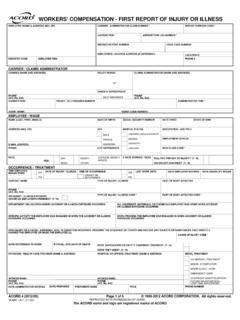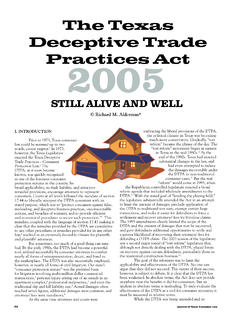Transcription of TEXAS WEAPONS LAWS - Criminal defense lawyer
1 TEXAS WEAPONS laws Among the more frequently asked questions of the District Attorney s Office are those that relate to the possession or carrying of WEAPONS . All persons are presumed to know the law and most citizens abide by the law, but the following summary of laws in TEXAS relating to the possession or carrying of WEAPONS is offered to assist the public in following the law. Generally the penal provisions related to possession of WEAPONS are found in Chapter 46, Penal Code of TEXAS . The following material in black type is taken from the Penal Code of TEXAS . The material in blue type is taken from cases decided by the Courts of Appeal and the Court of Criminal Appeals of the State of TEXAS which interpret the statutes. The material in red type contains commentary. It is important to note that when the statutes prohibit the possession or carrying of firearms they are referencing any firearm. When the reference is to a pistol it will say handgun.
2 Sec Definitions In this chapter: (1) Club means an instrument that is specially designed, made, or adapted for the purpose of inflicting serious bodily injury or death by striking a person with the instrument, and includes but is not limited to the following: (A) blackjack; (B) nightstick; (C) mace; (D) tomahawk. Tatom v. State, 555 459 (Tex. Crim. App. 1977) The pair of nun-chucks in question are in the record. One of the alleged WEAPONS consists of two pieces of laminated wood. Each piece is over eleven inches long and is an inch in diameter. Holes have been drilled in the center of an end of each piece and at an inch below. The rope connecting the two pieces of wood is threaded through the four holes and knots tied on the side of each piece. There is three inches of rope between the ends of each piece of wood. Observing them, we hold that the trial judge had before him sufficient evidence to conclude that they were designed for the purpose of inflicting serious bodily injury or death upon a person by striking him.
3 Whether the weapon was used solely for karate practice or not, or whether it was used solely for defensive purposes, the evidence sufficiently demonstrated that it was a club as defined in the statute. Alexander v. State, 617 269 (Tex. Crim. App. 1981) The fact that an object is capable of inflicting serious bodily injury or death alone does not bring the object within the definition of club. Instruments readily capable of inflicting serious bodily injury but not specifically designed to do so, such as baseball bats and rolling pins, are excluded, if a person carrying one of them has intent to use them to inflict injury and his Criminal design progresses far enough, however, he can be prosecuted for an attempted or completed assault. The court then found a nylon cord attached to a twelve-inch motorcycle chain was insufficient adaptation to find it to be a club under the statute. Same result in a case where defendant possessed a tire knocker (18 inch long piece of hickory with a leather thong tied through handle) used to check air pressure in truck tires.
4 It was not specially designed, made or adapted for the purpose of inflicting death or serious bodily injury by striking a person. Coleman v. State, 790 369 (Tex. 1990). Items that can be used to commit assault such as baseball bats are not clubs because they are not adapted for the purpose. However a sock with a roll of coins in it has been adapted for the purpose so could be a club. (2) Explosive weapon means any explosive or incendiary bomb, grenade, rocket, or mine, that is designed, made or adapted for the purpose of inflicting serious bodily injury, death, or substantial property damage, or for the principal purpose of causing such a load report as to cause undue public alarm or terror, and includes a device designed, made or adapted for delivery or shooting an explosive weapon. (3) Firearm means any device designed made, or adapted to expel a projectile through a barrel using the energy generated by an explosion or burning substance or any device readily convertible to that use.
5 Firearm does not include a firearm that may have, as an integral part, a folding knife blade or other characteristics of WEAPONS made illegal by this chapter and that is: (A) an antique or curio firearm manufactured before 1899; or Cantu v. State, 802 1 (Tex. Antonio 1990, pet. ref d) Illegal characteristic of firearm manufactured prior to 1899 must have been an integral part of the weapon as manufactured. (B) a replica of an antique or curio firearm manufactured before 1899, but only if the replica does not use rim fire or center fire ammunition. Several defendants have sought to defend WEAPONS cases or other cases involving use of WEAPONS by arguing that the WEAPONS was made before 1899, therefore are antiques. The courts have rejected this approach saying in effect that the antique or curio exception applies to treating the items as antiques, not to using them as WEAPONS . (4) Firearm silencer means any device designed, made, or adapted to muffle the report of a firearm.
6 (5) Handgun means any firearm that is designed, made, or adapted to be fired with one hand. This definition applies to what everyone refers to as a pistol. A cut off rifle or shotgun is still a rifle or shotgun and is illegal if shorter than the statutory lengths set out below. (6) Illegal Knife means a: (A) knife with a blade over five and one half inches; Rainer v. State, 763 615 (Tex. 1989, pet. ref d) To determine length, measure entire length of blade past handle, not just the sharpened portion of the blade. Same result in McMurrough v. State, 995 944 (Tex. Worth 1999). (B) hand instrument designed to cut or stab another by being thrown; Albert v. State, 659 41 (Tex. [14th Dist.] 1983, pet. ref d) Martial arts throwing star qualifies as a hand instrument designed to cut or stab another by being thrown . (C) dagger including but not limited to a dirk, stiletto, and poniard; Armendariz v.
7 State, 396 132 (Tex. Crim. App. 1965) A knife slightly over seven inches in length when open, equipped with a double guard, blade that locks open and is sharpened on both sides of blade for over an inch meets the definition of a dagger. (D) bowie knife; Mireles v. State, 192 241 (Tex. Crim. App. 1917) A knife in a scabbard with a blade nine inches long and a handle four or five inches long described as a butcher knife was embraced in the term bowie knife as defined by the Penal Code. (E) sword; or (F) spear. (7) Knife means any bladed hand instrument that is capable of inflicting serious bodily injury or death by cutting or stabbing a person with the instrument. (8) Knuckles means any instrument that consists of finger rings or guards made of a hard substance and that is designed, made, or adapted for the purpose of inflicting serious bodily injury or death by striking a person with a fist enclosed in the knuckles.
8 (9) Machine Gun means any firearm that is capable of shooting more than two shots automatically, without manual reloading, by a single function of the trigger. (10) Short-barrel firearm means a rifle with a barrel length of less than 16 inches or a shotgun with a barrel length of less than 18 inches, or any weapon made from a shotgun or rifle if, as altered, it has an overall length of less than 26 inches. (11) Switchblade knife means any knife that has a blade that folds, closes, or retracts into the handle or sheath, and that: (A) opens automatically by pressure applied to a button or other device located on the handle; or (B) opens or releases a blade from the handle or sheath by the force of gravity or by the application of centrifugal force. This definition includes a butterfly knife . (12) Armor-piercing ammunition means handgun ammunition that is designed primarily for the purpose of penetrating metal or body armor and to be used principally in pistols and revolvers.
9 (13) Hoax bomb means a device that: (A) reasonably appears to be an explosive or incendiary device; or (B) by its design causes alarm or reaction of any type by an official of a public safety agency or a volunteer agency organized to deal with emergencies. (14) Chemical dispensing device means a device, other than a small chemical dispenser sold commercially for personal protection , that is designed, made, or adapted for the purpose of dispensing a substance capable of causing an adverse psychological or physiological effect on a human being. Briggs v. State, 746 331 (Tex. 1988, pet ref d) Tear gas grenade manufactured for United States Armed Forces for use as a riot control device, activated by pulling pin, with no user control over direction of spray, not sold for personal protection violates statute. This does not apply to the small key chain type sprayers designed for personal protection .
10 (15) Racetrack means a facility licensed under the TEXAS Racing Act for the conduct of pari-mutuel wagering on greyhound racing or horse racing. (16) Zip gun means a device or combination of devices that was not originally a firearm and is adapted to expel a projectile through a smooth-bore or rifled-bore barrel by using the energy generated by an explosion or burning substance. Unlawfully Carrying WEAPONS (a) A person commits an offense if he intentionally, knowingly, or recklessly carries on or about his person a handgun, illegal knife or club. Masters v. State, 685 654 (Tex. Crim. App. 1985) The prohibition against carrying WEAPONS does not violate the Federal or State Constitutional right to bear arms. Crain v. State, 153 155 (Tex. Crim. App. 1913) It is a violation of the law to carry a pistol, even though one should place one part of it in one pocket and another part in another pocket.






